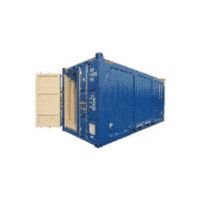 In December, we here at Specialcontainer.dk received another request, which again made us think more about “What can we change on an offshore container, in order for it to still uphold DNV 2.7-1 requirements for acceptance?” Often we have needed an easy-to-read “DNV for Dummies” guide instead of the 60 pages DNV 2.7-1- standard. You probably remember the “dummies” book with this little fellow, that tells you about everything from advertising to poker. So in this newsletter we share part of our own “DNV for Dummies” guide with you.
In December, we here at Specialcontainer.dk received another request, which again made us think more about “What can we change on an offshore container, in order for it to still uphold DNV 2.7-1 requirements for acceptance?” Often we have needed an easy-to-read “DNV for Dummies” guide instead of the 60 pages DNV 2.7-1- standard. You probably remember the “dummies” book with this little fellow, that tells you about everything from advertising to poker. So in this newsletter we share part of our own “DNV for Dummies” guide with you.
What is DNV 2.7-1 then?
Well… DNV 2.7-1 contains requirements that offshore containers have to uphold. By offshore containers we mean offshore transport containers, offshore service containers, offshore waste skips etc. These requirements need to be upheld even though you alter the containers. In this mini-guide we will focus on what you should take into account when looking at DNV 2.7-1 approved containers.
Primary and Secondary…?
When you wish to re-model certain parts of a DNV 2.7-1 approved containers, you need to be aware that the container basically consists of 2 parts: The Primary structure and the Secondary structure.
The primary part is the skeleton structure and this part is the basis of the container’s strength and endurance. It is the load carrying part. Among other things, the primary structure consists of:
– Load carrying and supporting frames
– The panels, such as the floor and shelves
– Fork lift pockets
– Pad eyes
As a rule of the thumb you should never re-model, weld, repair, etc. on the primary part without DNV first reviewing the effects on the container.
The secondary structure are parts that are not considered as load carrying for the purposes of the design calculations and consists of:
– Side and roof panels
– Doors
– Lashing rings
The secondary structure is for practical purposes, such as preventing the load from falling out of the container or to simply have it waterproof and/or shockproof. This makes it possible to change sides, roof, door etc. with a little know how. Although, it is always advisable to contact DNV first for an evaluation of the re-design and maybe an inspection of the container after the changes have been made.
I hope this answers some questions regarding DNV and will help you on your way regarding DNV’s requirements. If it should not be stated in the dossier of documents received with the container, we can help clarifying what is a secondary and primary structure of the container. If you have further questions regarding DNV or if you are looking for an offshore container, then call us. As of recently, we have new 8’ and 10’ on stock in Ribe, Denmark, which can be delivered to you shortly.






